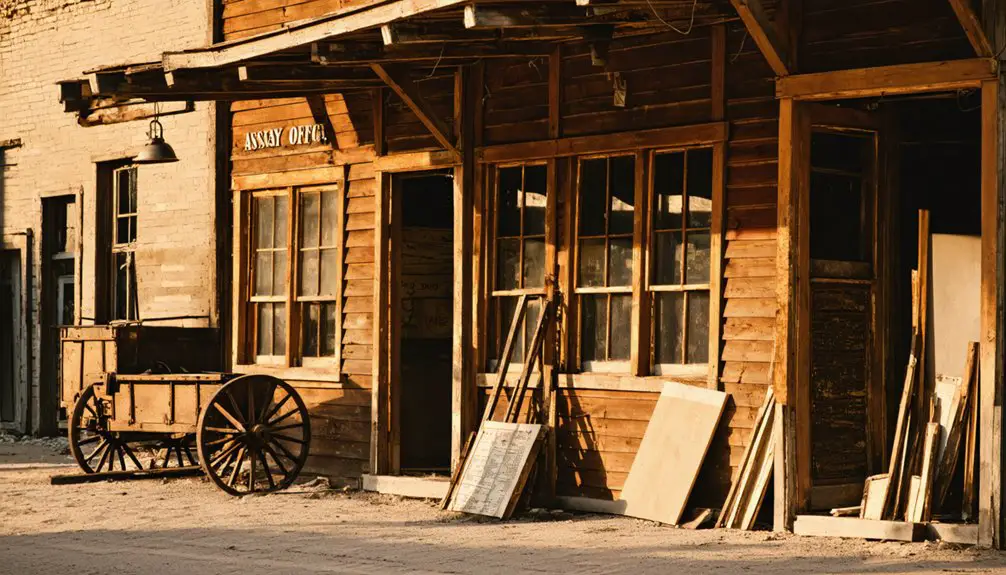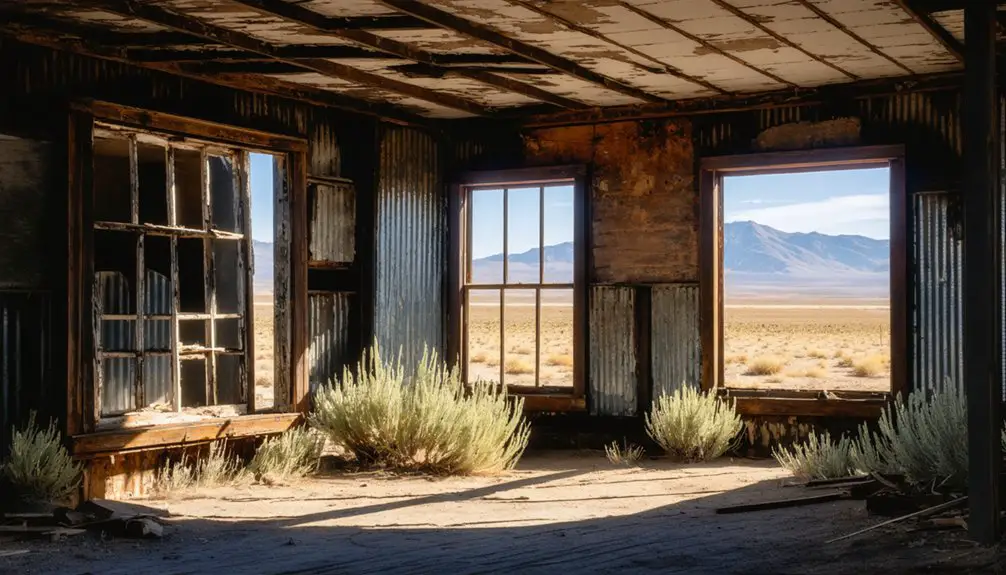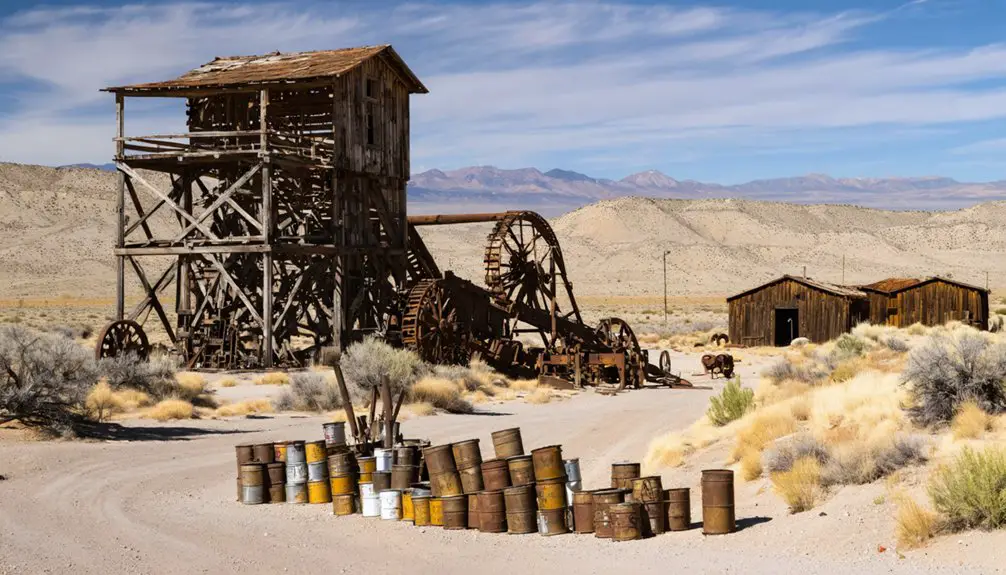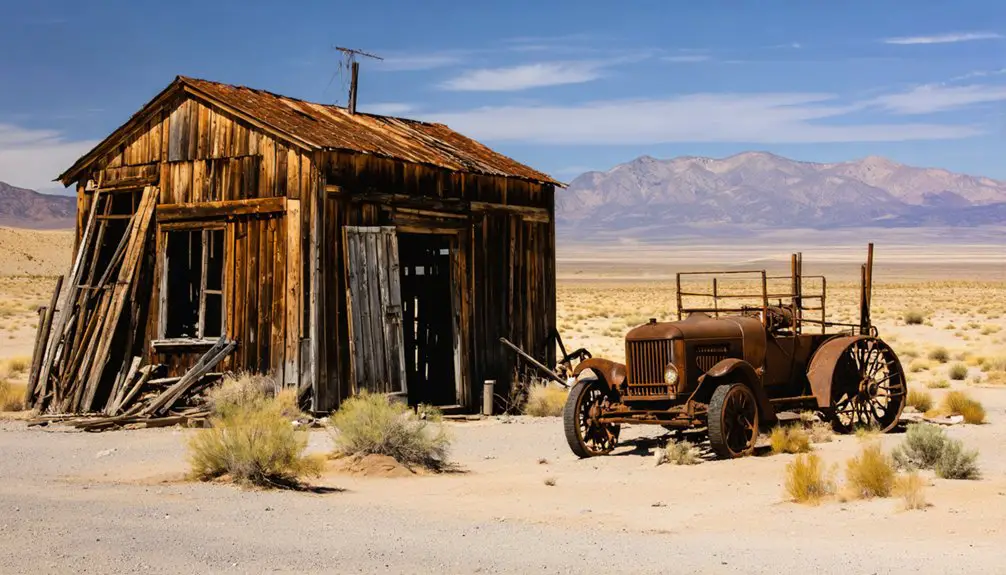You’ll find Gold Acres ghost town in Lander County, Nevada, where gold’s discovery in 1922 sparked a mining boom. By 1936, Consolidated Mining Company had built 40 houses, and the population reached 300 residents by 1940. The town thrived through World War II, shifting to open-pit mining in 1942 and generating $10 million in gold and silver by 1961. While the mines have long since closed, the site’s scattered foundations and Orvil Jack’s famous turquoise legacy tell deeper stories of Nevada’s mining past.
Key Takeaways
- Gold Acres was discovered in 1922 and became a thriving mining community by 1935, reaching 300 residents at its peak in 1942.
- The town developed around gold mining operations within the Roberts Mountains Formation, generating $10 million in gold by 1961.
- The community featured 40 houses, two mercantile stores, a schoolhouse, and essential services supporting the mining workforce.
- Operations transitioned from underground to open pit mining in 1942, making Gold Acres one of Nevada’s largest gold producers.
- Today, only foundations and mining relics remain, accessible via rough gravel roads requiring 4WD vehicles and careful navigation.
The Birth of a Mining Town (1936-1940)
Although the Gold Acres deposit was initially discovered in 1922, the town’s true beginning emerged in 1935 when mining operations commenced in the North Pit area using underground methods.
You’ll find that early mining under the Consolidated Mining Company’s direction quickly transformed this remote Nevada location into a bustling community by 1936.
Within just a few years, community development flourished as nearly 40 houses sprang up to accommodate the growing workforce.
The mine’s operations were notably situated within the Roberts Mountains Formation, which contained rich deposits of silty limestone that proved highly productive for gold extraction.
By 1940, the population had swelled to 300 residents, and you’d have found two mercantile stores serving the town’s needs.
A successful and happy atmosphere characterized the town during its operational years.
Despite challenges with processing refractory ore containing carbon in clay, the mine proved profitable, generating $213,000 in gold production by 1940, establishing Gold Acres as a significant player in Nevada’s mining scene.
London Extension Company Takes Over
During the early 2000s, London Extension Company strategically acquired control of the London Extension Pit, situated north of the original Gold Acres Pit in Nevada. Their focus centered on extracting high-grade refractory ore exceeding 3.4 g/t gold from an area spanning 180 x 750 meters.
You’ll find the pit’s unique geology defined by the Island Fault, which strikes NNE and dips 50° northwest. The company’s mining operations concentrated on carbonate rocks within an imbricate shear zone, requiring precise geological modeling to navigate the complex fault structures. As of December 2018, Gold Acres maintained 8.07 Mt of refractory ore grading 2.88 g/t Au.
While the site’s historical significance traces back to major production in the 1950s, London Extension Company’s activities remained small-scale, primarily during 2000-2001. The property’s rich history began when mining first started in 1935, transitioning from underground methods to open pit operations by 1942. They extracted specialized refractory ore that required third-party processing, marking a distinct chapter in Gold Acres’ mining heritage.
Daily Life in Gold Acres
Daily life in Gold Acres revolved around mining work, but you’d find a small yet active community supporting around 300 residents at its peak in 1942.
Similar to the residents of Batty who frequently drive 75 miles to groceries, the Gold Acres community relied heavily on their local stores for basic needs. You could get your basic supplies at one of two stores in town, where miners and their families would gather to shop and socialize. The town was operated by the London Extension Company beginning in 1942.
Your children would attend the local school, which served as both an educational center and a hub for community gatherings in this remote Nevada mining settlement.
Community Gatherings and Events
Life in Gold Acres revolved around vibrant community gatherings that strengthened bonds between mine workers and their families.
You’d find residents congregating at the two general stores, which served as social hubs where news and goods were freely exchanged. During work breaks, miners would gather near the mills, sharing stories and forging friendships.
The mining companies helped foster these social bonds by sponsoring celebrations marking significant mining achievements. The population would often reach up to 20,000 during peak mining operations, creating a bustling social atmosphere.
In this isolated setting, you’d witness neighbors supporting each other through informal networks, whether maintaining equipment or helping with mine claim work.
The town’s rhythm followed the mining shifts, with workers and families coming together for dances, card games, and music gatherings in communal spaces. Similar to how three railroads connected Goldfield during its peak, these social connections kept the community united.
The relative isolation only deepened the community’s reliance on one another.
School and Education
As Gold Acres grew into an established mining community, its commitment to education took shape through a simple schoolhouse that served the children of miners and settlers.
You’d find students learning basic literacy skills – reading, writing, and arithmetic – in a modest structure that reflected the town’s practical needs. Similar to Bishop Manogue Catholic, the school faced typical education challenges of Nevada’s mining communities, including inconsistent access to textbooks and fluctuating student populations that rose and fell with mining activity.
Like other Nevada mining towns after 1934, the school evolved to embrace cultural integration, moving away from rigid disciplinary approaches toward more inclusive educational practices.
The schoolhouse doubled as a community center, where daily learning fostered bonds between families and helped maintain the social fabric of Gold Acres. Teachers struggled with poor compensation, which often led to high turnover rates in rural mining communities like Gold Acres.
Store and Supply Operations
The commercial heart of Gold Acres centered on two fundamental stores that sustained both miners and residents throughout the town’s active years.
You’d find these establishments stocking everything from basic groceries to essential mining supplies, serving as critical lifelines for the community’s daily needs.
Beyond their retail function, these stores became natural gathering spots where you could catch up on local news, check community bulletins, or collect mail.
Store inventory directly reflected the town’s economic pulse, rising and falling with mining fortunes. You might’ve bartered or used credit when cash was scarce, typical of the tight-knit mining community’s practices.
When mining operations ceased in 1961, these stores – once bustling with activity – quickly shuttered, marking a definitive end to Gold Acres’ vibrant community life.
The Town’s Golden Years

By 1940, you’d find Gold Acres transforming from a fledgling mining operation into a bustling community of 300 residents, driven by the success of its gold production which reached $213,000 that year.
Under London Extension Company’s management from 1942, you could witness the rapid development of town infrastructure, including two mills, two stores, and a school.
You’d see daily life revolve around the mining economy, with various businesses emerging to support both the mining operations and the growing residential population.
Mining Drives Population Growth
During World War II, Gold Acres emerged as one of Nevada’s most productive mining districts, sparking significant population growth that would define its golden years.
The mining migration began in earnest when operations shifted from underground to open pit mining in 1942, creating numerous job opportunities that attracted workers and their families to the area.
Workforce dynamics evolved through the 1950s as Gold Acres became one of Nevada’s largest gold producers, generating $10 million in gold and silver value by 1961.
You’d have seen a thriving community develop around the mines, with infrastructure and housing expanding to accommodate the population influx.
The town’s stability was reinforced by continuous mining operations, technological improvements, and the development of ancillary services, creating a more sustainable economic environment than typical boom-bust mining settlements.
Business and Daily Life
As mining operations flourished, Gold Acres developed into a vibrant company town where daily life centered around the mining industry’s rhythms.
You’d find two general stores stocking everything from groceries to mining equipment, while the company-provided “manwagon” transported workers to and from the mines.
The business dynamics reflected a tight-knit community of about 300 residents by the early 1940s.
You’d see miners and their families living in company-owned housing, children attending the local school, and community resilience evident in the social gatherings.
Beyond mining, enterprising residents like Orvil Jack pursued turquoise mining and crafts production.
The town maintained essential services, including two mills, mail delivery, and basic medical care, until the mining company’s closure in 1961 triggered the community’s rapid decline.
The Legacy of Orvil Jack’s Turquoise
When Orvil Jack and his wife Bessie moved to Nevada in 1956, they established what would become one of the state’s most distinctive turquoise mining operations. Their Blue Ridge Mine, also known as the Orvil Jack mine, created a family legacy that would shape Nevada’s turquoise industry for decades to come.
- Produced rare lime green turquoise, setting it apart from typical blue varieties
- Featured unique spider web matrix patterns and translucent blue nuggets
- Yielded occasional lemon-yellow stones, all naturally occurring
- Became prized among bolo tie makers and collectors
- Maintained small-scale family operations despite increasing regulations
The Jack family’s commitment to turquoise mining near Gold Acres preserved this unique operation through environmental and regulatory challenges of the late 20th century, cementing their place in Nevada’s mining heritage.
Walking Through What Remains

Today’s visitors to Gold Acres encounter a stark contrast to its bustling mining past. You’ll find only foundations and scattered wooden rubble where 40 houses, two mills, stores, and a school once stood between 1936 and 1961.
Your exploration challenges begin on narrow, overgrown pathways that you can’t navigate by vehicle. You’ll need to proceed on foot, where historical discoveries await in the form of foundational outlines and mining relics.
Venture beyond the roads to discover Gold Acres’ secrets, where narrow trails lead to remnants of its mining heritage.
The site’s isolation and minimal signage demand careful planning, especially as daylight fades. You’ll traverse typical Nevada mining terrain – arid landscapes that hold traces of the town’s former 300 residents.
While walking reveals subtle remnants not visible from maps, you’ll need resilience to navigate the unmarked paths through this abandoned mining landscape.
Reaching Gold Acres requires careful navigation through Lander County‘s challenging terrain. You’ll need to shift from State Route 306 onto increasingly rough gravel roads, where road conditions deteriorate to dirt paths suitable only for 4WD vehicles.
- Pack essential navigation tools including GPS, compass, and detailed topographic maps
- Drive a high-clearance 4WD vehicle equipped with spare tires and extra fuel
- Travel during daylight hours and mark waypoints to guarantee safe return
- Carry emergency supplies and notify others of your planned route
- Follow existing paths to protect the site and comply with preservation laws
Begin your journey early, as the final approach may require walking when vehicle paths become too narrow or overgrown.
A Place in Nevada’s Mining Heritage

The Gold Acres mining district emerged as a significant player in Nevada’s mineral history after its 1922 discovery, though prospectors had traversed the area since 1862.
Mining techniques evolved from underground methods in 1935 to open pit operations by 1942, marking a pivotal shift in the district’s development.
The economic impact was substantial, with Gold Acres becoming one of Nevada’s largest gold producers between 1942 and 1961, generating approximately $10 million in precious metals.
You’ll find its legacy in the bustling community of 300 residents it once supported, complete with schools and stores.
The district’s importance extended through World War II, when most precious metal mines were shuttered.
Even after its 1961 closure, operations continued sporadically through the 1980s, cementing Gold Acres’ place in Nevada’s rich mining heritage.
From Bustling Streets to Silent Ruins
Once a thriving community of 300 residents, Gold Acres began its descent into silence after the Consolidated Mining Company’s closure in 1961. Economic challenges and rising operational costs made mining unprofitable, triggering a mass exodus from this remote Nevada settlement.
- Multiple businesses, two mills, and a school once lined the bustling main street.
- Post-war industrial shifts drew workers away to other opportunities.
- Remote location and harsh desert conditions deterred long-term settlement.
- Mining equipment fell silent as gold and silver yields diminished.
- Roads gradually became overgrown, isolating the remaining structures.
Today, you’ll find the community’s physical remnants slowly weathering in the desert. While some nearby turquoise claims remain active, Gold Acres stands as a symbol of the boom-and-bust cycle that defined Nevada’s mining communities.
Frequently Asked Questions
Were Any Notable Crimes or Accidents Reported in Gold Acres During Its Operation?
You won’t find records of mysterious disappearances or major mining accidents in available sources. The town’s modest size and short operation left no documented crimes or notable incidents between 1936-1961.
What Happened to the Mining Equipment and Machinery After the Town Closed?
Like 80% of Nevada ghost towns, mining equipment at Gold Acres was mostly dismantled and sold for reuse elsewhere, though some heavier machinery stayed behind due to removal costs, rather than historical preservation.
Did Any Famous People Visit or Have Connections to Gold Acres?
You won’t find any documented famous visitors or significant historical connections to Gold Acres. The town’s only notable figure was Orvil Jack, a local turquoise miner known mainly among mineral enthusiasts.
What Was the Average Wage for Miners Working in Gold Acres?
Ever wonder what it was like earning a living in the mines? While specific Gold Acres mining wages aren’t documented, you’d have seen earnings similar to regional averages—about $88,000 annually, making a strong economic impact.
Were There Any Churches or Religious Gatherings in the Town?
You won’t find any church history or religious significance in town records – there’s no evidence of formal churches or organized religious gatherings during Gold Acres’ active years from 1936 to 1961.
References
- https://bonnevillemariner.wordpress.com/2007/04/25/my-first-ghost-town-trip-part-i-the-search-for-gold-acres/
- https://www.youtube.com/watch?v=LP6gKVpSfu8
- https://findingnevadawild.com/goldfield-the-old-west-lives-in-nevadas-best-ghost-town/
- https://www.exploratography.com/blog-nv/eldorado-canyon-nelson-ghost-town-nevada
- https://nevadamagazine.com/issue/november-december-2016/3975/
- https://portergeo.com.au/database/mineinfo.asp?mineid=mn1180
- https://www.ghosttowns.com/states/nv/goldacres.htm
- https://westernmininghistory.com/mine-detail/10069103/
- https://pubs.usgs.gov/bul/1356/report.pdf
- https://portergeo.com.au/database/mineinfo.asp?mineid=mn1169



